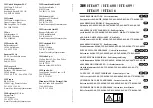
21
To reduce your reaction time, you
should:
A. Ride slower than the speed
limit.
B. Cover the clutch and the brakes.
C. Shift into neutral when slowing.
D. Pull in the clutch when turning.
TEST YOURSELF
5
Answer - page 47
L
Hazardous
road conditions that
require you to be alert, especially in
areas with limited visibility. Visually
“busy” surroundings could hide you
and your motorcycle from others.
Evaluate
Evaluate means to think about how
hazards can interact to create risks for
you. Anticipate potential problems and
have a plan to reduce risks, particularly
when faced with:
I
Road and surface characteristics
such as potholes, guardrails,
bridges, telephone poles and trees
that won’t move into your path, but
may influence your riding strategy.
I
Traffic control devices
including
traffic signals, warning signs, and
pavement markings, which will
require you to carefully evaluate
circumstances ahead.
I
Vehicles and other traffic
that
may move into your path and
increase the likelihood of a crash.
Think about your time and space
requirements in order to maintain a
margin of safety, and give yourself
time to react if an emergency arises.
Execute
Finally,
Execute
your decision. To
create more space and minimize harm
from any hazard:
I
Communicate
your presence with
lights and/or horn.
I
Adjust your speed
by accelerating,
stopping or slowing.
I
Adjust your position
and/or
direction by swerving, changing
lanes, or moving to another position
within your lane.
Apply the old adage “one step at a
time” to handle two or more hazards.
Adjust speed to permit two hazards
to separate. Then deal with them one
at a time as single hazards. Decision-
making becomes more complex with
three or more hazards. Evaluate the
consequences of each and give equal
distance to the hazards.
In potential high-risk areas, such as
intersections, shopping areas and school
and construction zones, cover the clutch
and both brakes to reduce the time you
need to react.
INTERSECTIONS
The greatest potential for conflict
between you and other traffic is at
intersections. An intersection can be
in the middle of an urban area or at
a driveway on a residential street —
anywhere traffic may cross your path of
travel. Over one-half of motorcycle/car
crashes are caused by drivers entering a
rider’s right-of-way. Cars that turn left in
front of you, including cars turning left
from the lane on your right, and cars on
side streets that pull into your lane, are
the biggest dangers. Your use of SEE
at intersections is critical.
















































